Home Decor
Spooky Halloween Delights: 7 Home Treats
Yearning for eerie delights this Halloween? Dive into seven spooky treats that will send shivers down your spine!
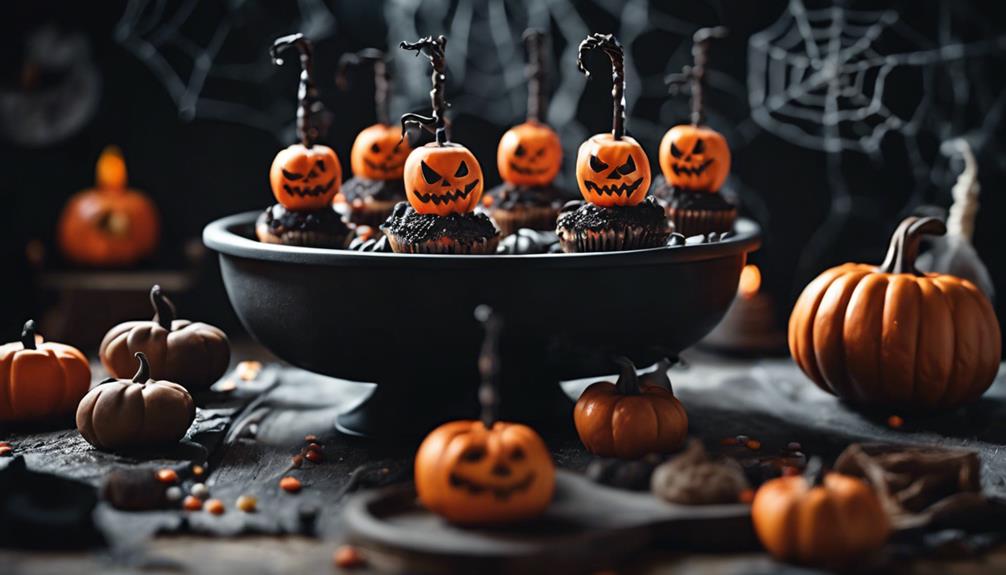
Step into Halloween fun with seven eerie treats that will thrill your guests at home. From mini pumpkins made of clementines to witches' fingers with pretzel and almond, these spooky snacks will delight. Don't miss out on mummy hot dogs in crescent roll dough for a creepy twist. Explore cake eyeballs, brainy cakes, and mummy brownies for dessert chills. Immerse yourself in Halloween magic with witch's brew punch and marshmallow ghosts. The delight doesn't stop there – each treat brings a touch of the eerie to your festivities, ensuring a hauntingly good time for all.
Key Takeaways
- Eerie snacks like Mini Pumpkin Clementines and Witches Fingers for a spooky twist.
- Creepy desserts such as Cake Eyeballs and Mummy Brownies for a frighteningly delicious treat.
- Haunted movie night treats like Halloween Cookie Pops and Eyeball Cookies for a fun movie experience.
- Seasonal goodies like Cake Eyeballs and Witches Fingers for a festive Halloween spread.
- Halloween Magic Treats with Witch's Brew Punch and Pumpkin Rice Krispie Treats for a customizable celebration.
Eerie Snacks
We love serving up Eerie Snacks at our Halloween parties to add a spooky touch to the festivities. One of our favorite treats is the adorable mini pumpkins, which are actually clementines with small pieces of celery stuck in the tops to resemble pumpkins. These aren't only cute but also provide a healthy option amidst all the sugary delights.
Another hit at our gatherings are the Witches Fingers made from pretzel rods with almond nails. These savory snacks always get a good reaction from our guests who appreciate the clever and slightly eerie presentation.
Mummy Hot Dogs are also a must-have for us. The combination of hot dogs wrapped in crescent roll dough to look like mummies isn't only tasty but also a fun way to play on the Halloween theme.
Creepy Desserts
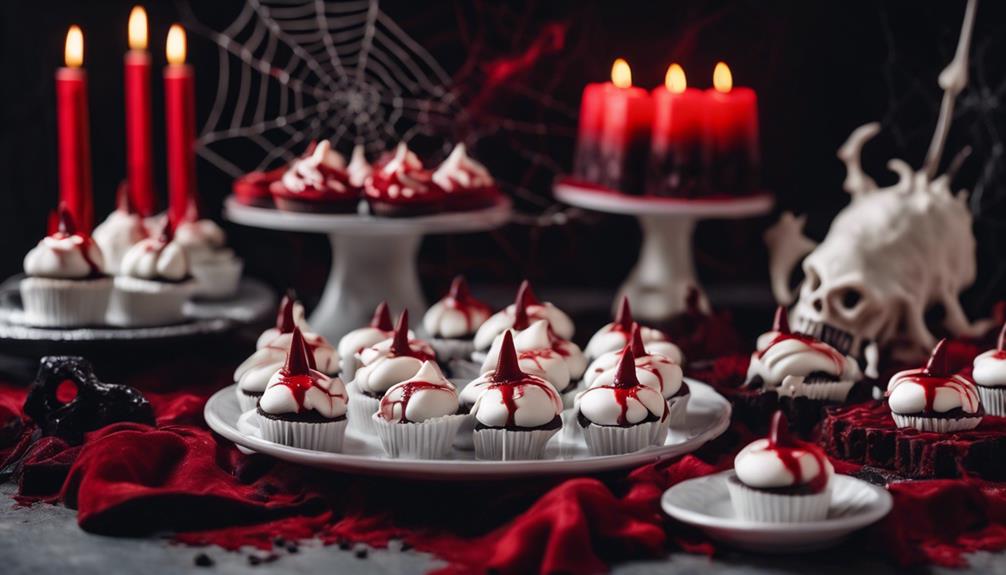
When crafting Creepy Desserts for Halloween, creativity knows no bounds. These eerie treats offer a delightful mix of spookiness and sweetness, making them a hit at any Halloween gathering.
Here are some popular options to explore:
- Cake Eyeballs: These delicious treats resemble realistic eyeballs with a cake base and a spooky eyeball design on top. They're sure to catch the eye of your guests.
- Brainy Cake: A brain-shaped cake that looks eerily realistic, complete with convoluted wrinkles and a pinkish hue. It's a creepy yet tasty dessert that will leave everyone impressed.
- Mummy Brownies: Brownies wrapped in white fondant or icing strips to mimic the look of a mummy. These cute and spooky treats are perfect for a Halloween dessert table.
- Unique Ingredients: Creepy desserts often incorporate unique ingredients like edible fake blood, gummy worms, and candy eyeballs to enhance the eerie theme and surprise your taste buds.
From cake pops to brain cakes, these Creepy Desserts are a creative way to add a ghoulish touch to your Halloween celebrations.
Haunted Movie Night Treats
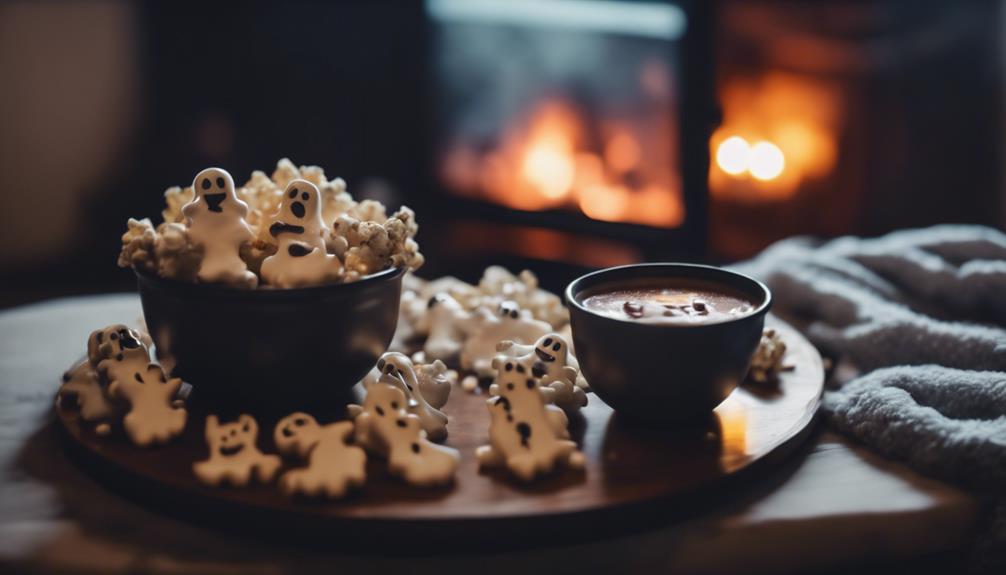
Set the stage for a spooky movie night with our selection of hauntingly delicious treats. Prepare Halloween Peanut Butter Cookie Pops to add a touch of festivity to your evening.
These themed treats, along with Mummy Brownies and Witches Fingers, will elevate your movie-watching experience.
Indulge in Halloween Chocolate Cookie Pops and Eyeball Cookies for a creepy yet tasty addition to your spread.
For a surprise twist, serve Freaky Frankenstein Cookies and Mummy Hot Dogs to delight your guests with a fun and spooky treat.
Combine these eerie delights with classic Halloween movies for a memorable and delicious evening of entertainment.
Enjoy the thrill of the season with these homemade treats that perfectly complement the spooky ambiance of your haunted movie night.
Gather your friends and family, dim the lights, and get ready for a spine-chilling yet delectable cinematic experience.
Spooky Seasonal Goodies
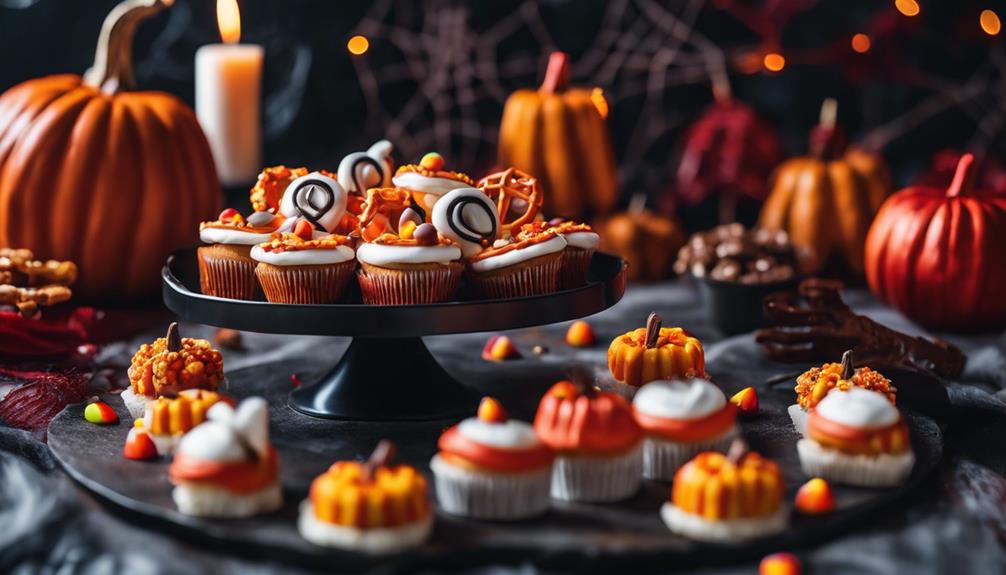
To continue exploring the array of eerie and delectable treats for your Halloween festivities, let's uncover the spine-chilling delights of Spooky Seasonal Goodies.
- Halloween Peanut Butter Cookie Pops: These fun and easy treats feature a peanut butter cookie base adorned with festive decorations, making them a delightful addition to your Halloween spread.
- Cake Eyeballs: Create a spooky dessert by molding cake crumbs and frosting into eyeballs, complete with a creepy effect using red gel for an extra frightful touch.
- Witches Fingers: A popular Halloween finger food, these eerie delights are crafted from pretzel rods, almond slices, and red decorating gel to give them a ghoulish appearance.
- Halloween Sugar Cookies: Classic treats that never fail to please, these sugar cookies are decorated with orange and black icing in playful Halloween shapes like pumpkins, bats, and ghosts, adding a festive flair to your party.
Halloween Magic Treats
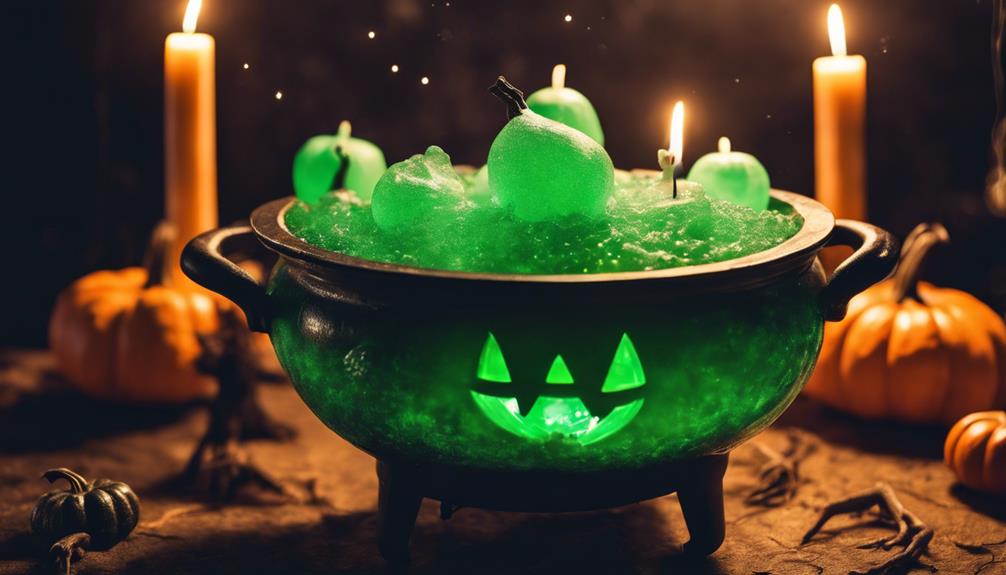
Let's explore the enchanting world of Halloween Magic Treats, where spooky flavors and creative designs come together to delight party guests of all ages. These fun and eerie treats are perfect for Halloween gatherings, adding a playful touch to the celebration.
Halloween Magic Treats often feature festive elements like eyeballs, ghosts, pumpkins, and monsters, sparking the imagination and creating a spooky atmosphere.
Some popular choices for Halloween Magic Treats include Witch's Brew Punch, a creepy concoction that bubbles and fizzes with mysterious flavors. Marshmallow Ghosts are also a hit, with their fluffy white forms and googly eyes bringing a ghostly charm to the table. And who can resist the temptation of Pumpkin Rice Krispie Treats, shaped like pumpkins and bursting with a delicious crunch?
Not only are these treats delicious, but they can also be customized to fit different themes or preferences, making them versatile and enjoyable for all ages. Halloween Magic Treats are a must-have for any spooky celebration!
Festive Home Treats
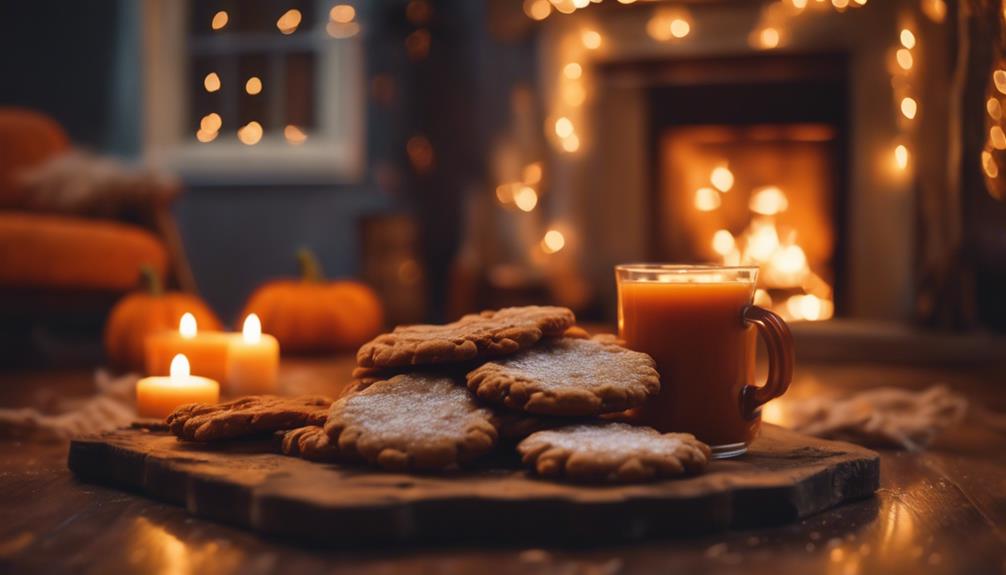
Exploring the world of festive home treats for Halloween reveals a delightful array of spooky and delicious options to elevate your celebrations.
From simple cookies and cupcakes to elaborate cakes and finger foods, there's a wide range of options to suit every taste bud.
Creating homemade Halloween treats can add a fun and personalized element to your festivities, making them even more special.
Themed cookies, cakes, and candies are among the top picks for festive home treats, allowing for creativity in both decoration and flavor.
Deliciously Haunting Delights
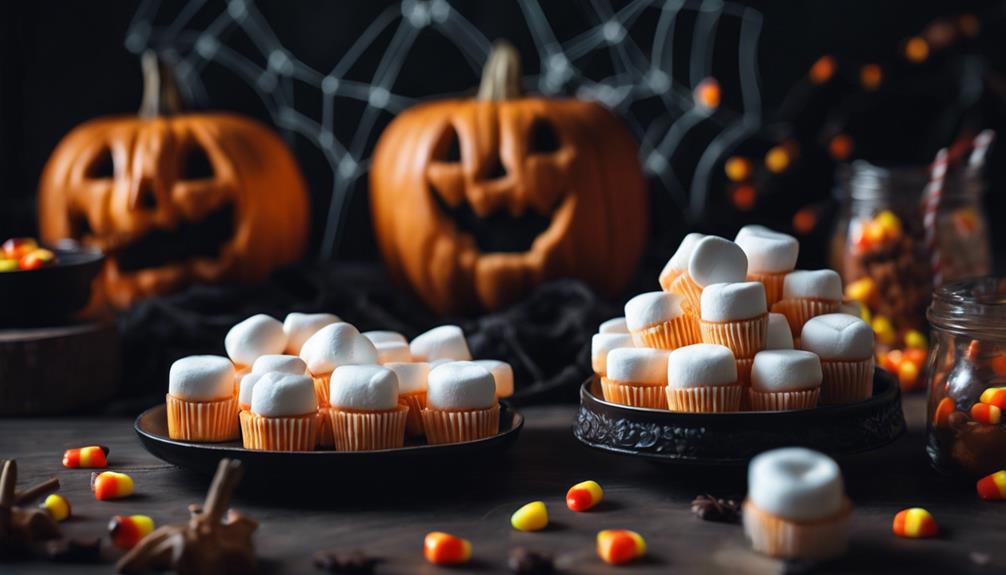
Get ready to tantalize your taste buds with some ghastly treat recipes and Halloween party snacks that will leave your guests hauntingly satisfied.
From Brainy Cake to Witches Fingers, these creatively spooky delights are sure to add a touch of eerie fun to your celebrations.
Ghastly Treat Recipes
When planning a Halloween party, incorporating ghastly treat recipes adds a spooky and delicious touch to the festivities. These themed delights aren't only tasty but also perfect for setting the eerie mood of the celebration.
Here are some popular and creatively spooky treat options to impress your guests:
- Ghostly Marshmallows: These fluffy treats are transformed into ghostly figures with the help of some white chocolate and edible googly eyes.
- Eyeball Cookies: Make ordinary cookies look terrifyingly delicious by decorating them with a simple icing design that resembles eerie eyeballs staring back at you.
- Mummy Brownies: Wrap your brownies in crisscrossed white chocolate strips to give them the appearance of delicious mummies, perfect for a Halloween spread.
- Creepy Cupcakes: Get creative with your cupcake decorations by adding spooky elements like tombstones, spiders, or even edible fake blood to give your guests a frightfully delightful treat.
Halloween Party Snacks
We love indulging in a variety of deliciously haunting delights when hosting a Halloween party. Halloween party snacks are a fun and festive way to celebrate the spooky season with friends and family. These treats can range from cookies, cakes, finger foods, to decorative snacks.
Popular options for Halloween party snacks include witches' fingers, mummy hot dogs, creepy crawler deviled eggs, and pumpkin-themed treats. Ghostly delights like marshmallow ghosts and ghostly custards add a whimsical touch to any Halloween gathering. Interactive treats such as pumpkin patch dirt cups can engage guests of all ages in the Halloween spirit.
Whether you prefer sweet or savory snacks, there's a wide array of hauntingly delicious options to choose from when planning your Halloween party menu. These snacks not only taste great but also add a spooky and festive vibe to your celebrations.
Frequently Asked Questions
What Is the Best Halloween Treat?
The best Halloween treat is one that delights and spooks us in equal measure. While personal preferences vary, popular choices include candy apples, caramel corn, and Halloween-themed cookies.
For a savory twist, mummy hot dogs or witches' fingers can add a fun scare. Homemade treats like cupcakes or decorated cookies bring a personal touch to celebrations.
Ultimately, the best Halloween treat is the one that brings joy and a touch of Halloween magic to your festivities.
What Candy to Give Out on Halloween?
When choosing what candy to give out on Halloween, we want to take into account popular choices like Reese's Peanut Butter Cups and Snickers bars. These classics are always a hit with trick-or-treaters.
It's also important to think about any dietary restrictions or preferences in your community. Offering a mix of candy and non-candy treats like stickers or pencils can accommodate everyone.
What to Give Out for Halloween?
When deciding what to give out for Halloween, consider traditional candy treats like candy bars, lollipops, or gummy candies.
Healthier options such as mini packs of pretzels, popcorn, or fruit snacks are gaining popularity.
Non-food items like stickers, temporary tattoos, or small toys are also great choices.
For allergy-friendly treats, stickers, glow sticks, or small trinkets cater to kids with food allergies.
Homemade treats like cookies, popcorn balls, or mini cupcakes add a personal touch to Halloween giveaways.
Conclusion
To wrap things up, these spooky Halloween delights are sure to add a frightfully fun touch to your celebrations. From eerie snacks to deliciously haunting desserts, there's something for everyone to enjoy.
So why not whip up some festive treats, gather your friends and family, and indulge in some Halloween magic this season? Let's make this Halloween one to remember with these tasty home treats that are bound to leave you craving more.
Happy haunting!
Alfresco
Is Frenchic Alfresco Waterproof? Learn More!
Harness the power of Frenchic Alfresco paint's waterproof properties for your outdoor projects – discover its durability and protection against the elements here!
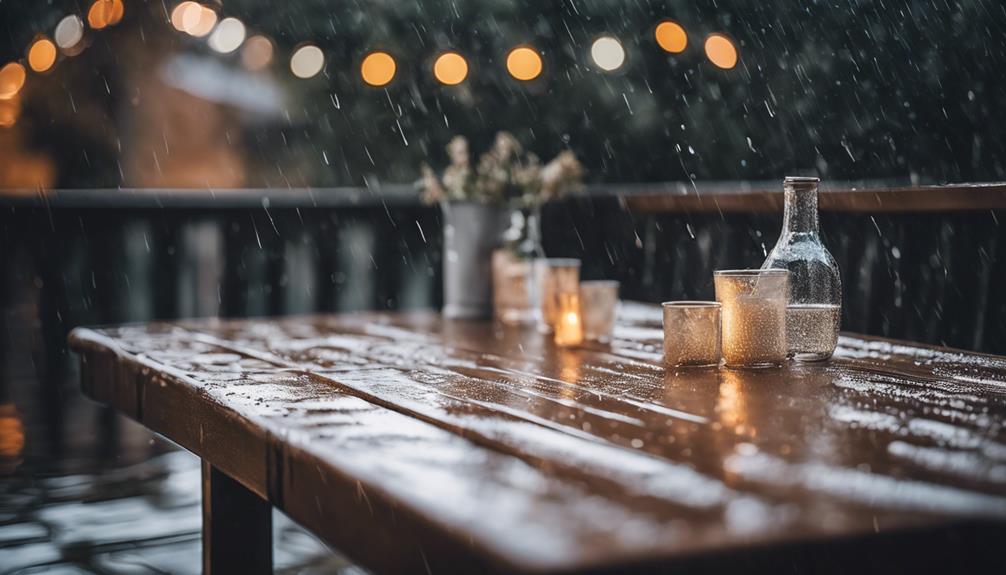
Frenchic Alfresco paint is highly water-resistant, offering excellent moisture protection for outdoor surfaces. With self-sealing and self-priming properties, it provides durability against varying weather conditions. This paint's weatherproof nature enhances its performance, safeguarding against elements like rain and sun exposure. Ideal for projects like garden furniture and front doors, it boasts UV resistance and a range of colors for a professional finish. Curing for at least 3 weeks in favorable climates guarantees longevity by creating a strong protective layer. Routine cleaning and inspection maintain its vibrant appearance. Discover more about Frenchic Alfresco's waterproof features for your outdoor endeavors.
Key Takeaways
- Frenchic Alfresco paint is highly water-resistant with excellent moisture protection.
- Offers weatherproof properties due to self-sealing and self-priming features.
- Provides durable UV resistance for outdoor projects.
- Full curing for at least 3 weeks enhances waterproofing.
- Regular maintenance ensures long-lasting waterproofing qualities.
Properties of Frenchic Alfresco Paint
Frenchic Alfresco paint offers a range of durable and weatherproof properties suitable for various indoor and outdoor surfaces. Being water-based, it provides excellent resistance to UV rays, making it ideal for projects exposed to sunlight.
This self-priming and self-sealing paint not only simplifies application but also guarantees a smooth and professional finish. Additionally, its algae-resistant feature minimizes the risk of mold growth, particularly important for outdoor applications.
The wide color palette of 26 best-selling colors, including limited editions, allows you to choose the perfect shade for your project. Whether you're painting wood, laminate, UPVC, composites, metal, render, or brick, Frenchic Al Fresco paint caters to a diverse range of surfaces.
With its exceptional durability and weatherproof characteristics, this paint stands out as a versatile option for both interior and exterior use, promising long-lasting results that maintain their quality over time.
Water-Resistance Vs. Waterproofing
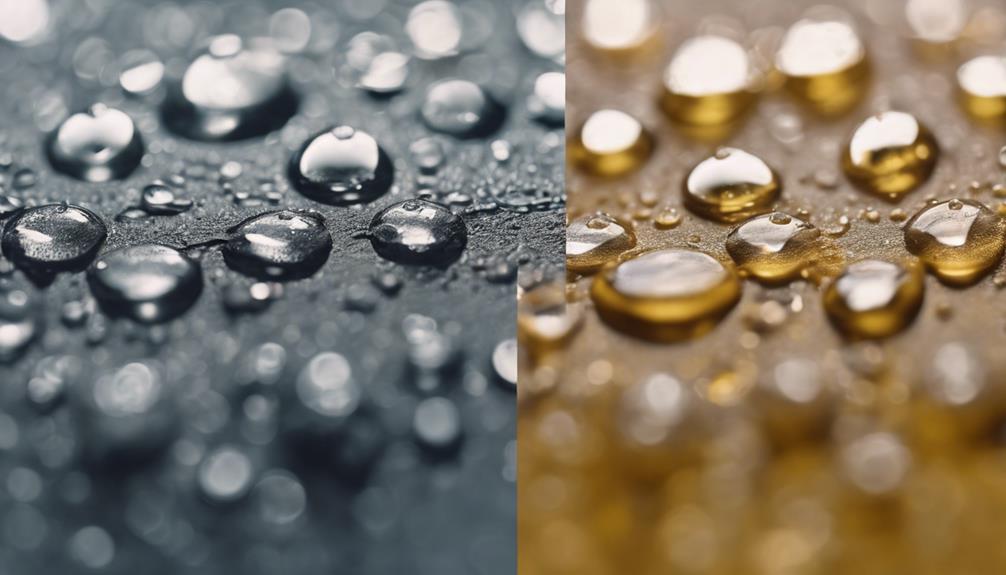
What distinguishes water-resistance from waterproofing in paint products?
When considering the water-resistance of Frenchic Al Fresco paint for exterior projects, it's important to grasp the distinction between water-resistance and waterproofing.
- Water-resistance: Frenchic Al Fresco paint offers high water-resistance, being durable, weatherproof, and UV resistant. This means it can withstand exposure to elements like rain and sun without significant damage.
- Moisture Protection: While not completely waterproof, the paint provides excellent moisture protection, preventing issues like flaking and peeling due to water exposure.
- Surface Durability: Designed for exterior projects, Al Fresco paint ensures a long-lasting finish on surfaces exposed to varying weather conditions, enhancing overall surface durability.
- Weatherproof: The self-sealing and self-priming properties of the paint not only reduce maintenance needs but also contribute to its weatherproof characteristics, further improving water-resistance.
Suitable Applications for Alfresco Paint
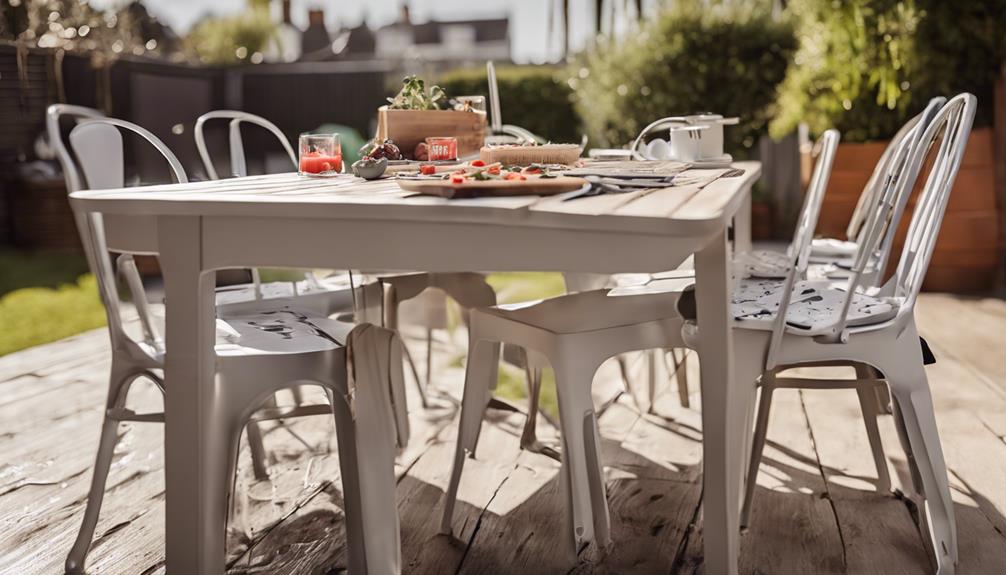
Al Fresco paint is best suited for a variety of outdoor projects, ranging from garden furniture to front doors, due to its durable and weather-resistant properties. The Al Fresco Range offers a versatile solution for enhancing the appearance of your outdoor spaces.
Whether you're looking to revamp your garden furniture or add a fresh coat to your front door, this water-based paint is designed to withstand the elements while maintaining a vibrant finish. Its self-priming and self-sealing nature make it a convenient choice for UPVC doors and various surfaces such as wood, laminate, composites, and metal.
The weatherproof and durable characteristics of Al Fresco paint guarantee long-lasting results, providing a protective layer that can endure outdoor conditions. With its UV resistance and ability to create a low, flat finish, this paint is ideal for both indoor and outdoor applications, offering a professional look that lasts.
Curing Process for Longevity
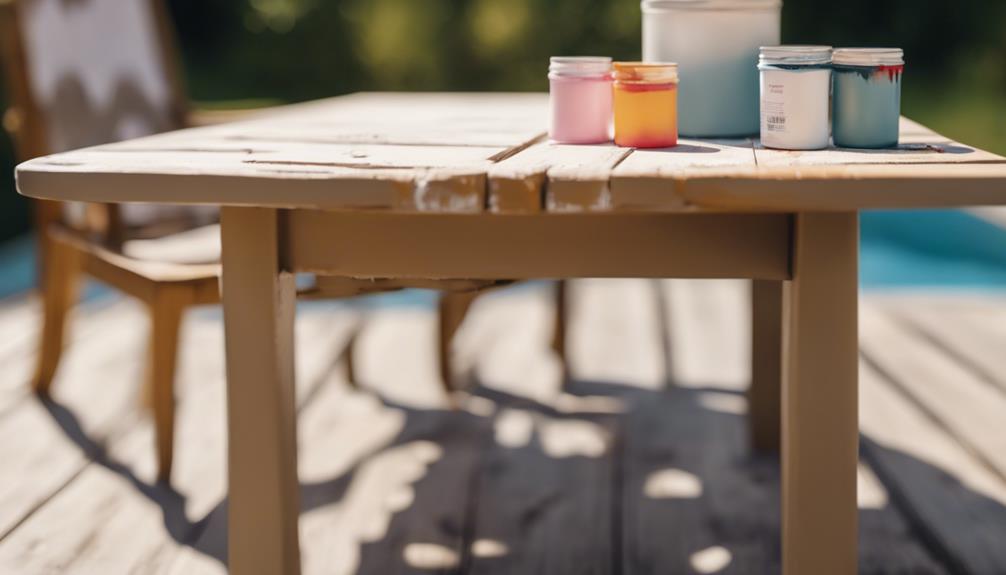
Ensuring proper curing of the paint is essential for maximizing its longevity and waterproofing capabilities. When dealing with Frenchic Al Fresco, the curing process plays an important role in creating a durable and weatherproof protective layer.
Here are some key points to keep in mind for the curing process:
- Allowing the paint to fully cure for at least 3 weeks is necessary for enhancing its durability and longevity.
- Best results are achieved when curing takes place in a warmer and drier climate.
- Proper curing helps the paint form a strong protective layer, making it more resistant to the elements.
- Following the instructions provided on the tin for the curing process is crucial to ensuring the paint's waterproofing properties are fully realized.
Maintenance Tips for Alfresco Paint
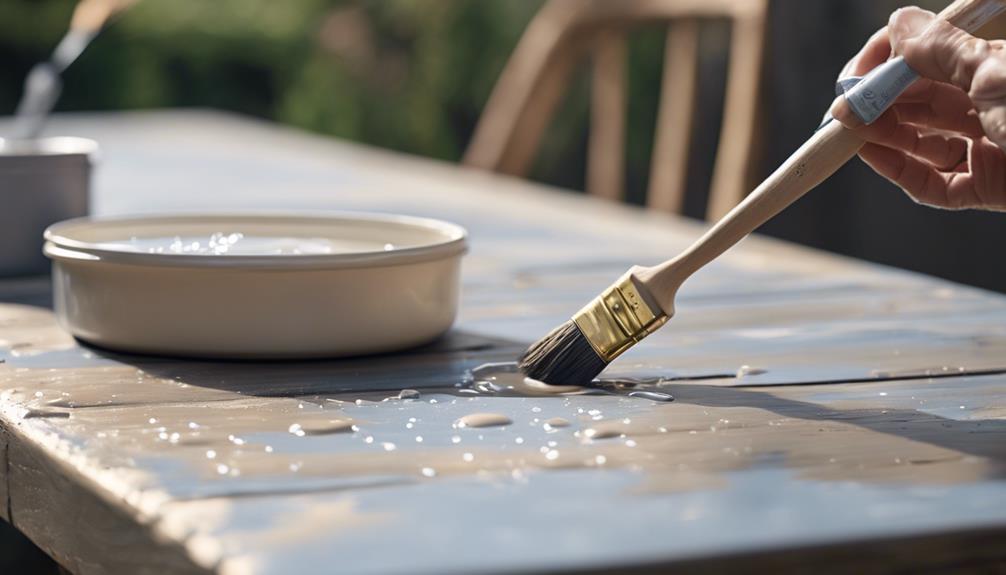
To maintain the durability and weatherproof qualities of Frenchic Alfresco paint, regular cleaning and inspection are crucial. Frenchic paints, especially those from the Al Fresco Inside/Outside Range, are designed to withstand outdoor conditions, but proper maintenance can prolong their lifespan.
For outdoor furniture coated with this water-based, weatherproof paint, wiping down surfaces with a mild detergent and water solution every few months can help remove dirt and debris that may accumulate. Additionally, inspecting the painted wood for any signs of wear or damage allows for timely touch-ups, preventing further deterioration.
UV resistance in Frenchic paints minimizes color fading, but it's still advisable to keep items protected from prolonged sun exposure. By following these maintenance tips, you can guarantee that your outdoor projects retain their vibrant appearance and protective qualities for years to come.
Conclusion: Is Frenchic Alfresco Waterproof?
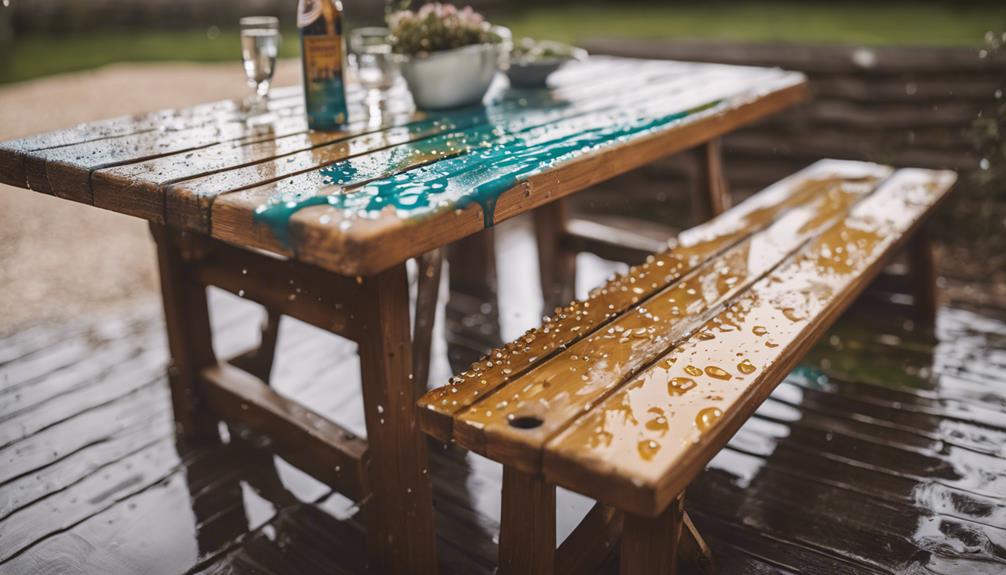
Frenchic Alfresco paint is indeed waterproof, providing long-lasting protection for your outdoor projects. This durable and weatherproof Al Fresco paint is specifically crafted for outdoor use, offering a reliable shield against the elements for your exterior surfaces.
Here are four key points reinforcing its waterproof qualities:
- UV Resistant: Frenchic Al Fresco paint is formulated to withstand the harmful effects of UV rays, preventing discoloration and fading over time.
- Self-Sealing and Self-Leveling: The paint's self-sealing properties help establish a protective barrier, while its self-leveling feature ensures a smooth and even finish that enhances its waterproof capabilities.
- Versatile Application: Suitable for various surfaces like wood, laminate, UPVC, composites, and metal, this paint adapts well to different materials, increasing its effectiveness in outdoor settings.
- Algae and Mould Resistance: Frenchic Al Fresco is designed to resist algae and mould growth, reducing the need for frequent maintenance and preserving the integrity of your exterior surfaces.
Frequently Asked Questions
Is Frenchic Alfresco Waterproof?
Yes, Frenchic Al Fresco paint is waterproof. It's designed for outdoor use, with excellent weather resistance, UV protection, and algae/mould inhibitors. It works on various surfaces, making it ideal for outdoor projects like furniture, fences, and sheds.
Can You Water Down Frenchic Alfresco Paint?
You can water down Frenchic Al Fresco paint if desired for a smoother application or a wash effect. However, diluting the paint may impact coverage and durability, so it's essential to adhere to recommended guidelines for best results.
Do You Need to Seal Frenchic Alfresco?
You don't need to seal Frenchic Al Fresco paint. It's self-sealing, water-based, and designed to be weatherproof and UV resistant. The paint is self-priming with a durable finish, eliminating the need for additional sealing products.
What Is so Special About Frenchic Paint?
Frenchic paint is renowned for its water-based, durable, and weatherproof properties, making it ideal for both indoor and outdoor projects. With self-levelling technology, easy application, and a range of vibrant colors, it stands out for its versatility and eco-friendly nature.
Conclusion
To sum up, Frenchic Alfresco paint offers excellent water resistance properties, making it suitable for outdoor applications. While it may not be completely waterproof, proper curing and maintenance can guarantee its longevity in various weather conditions.
By following the recommended guidelines for application and upkeep, you can enjoy the beauty and protection of Frenchic Alfresco paint for years to come. Remember, a little care goes a long way in preserving the quality and durability of your outdoor surfaces.
Home Decor
Dollar Store Spring Cottage Birdhouses
Bring spring charm to your outdoor space with a whimsical birdhouse crafted from just a few simple dollar store supplies.
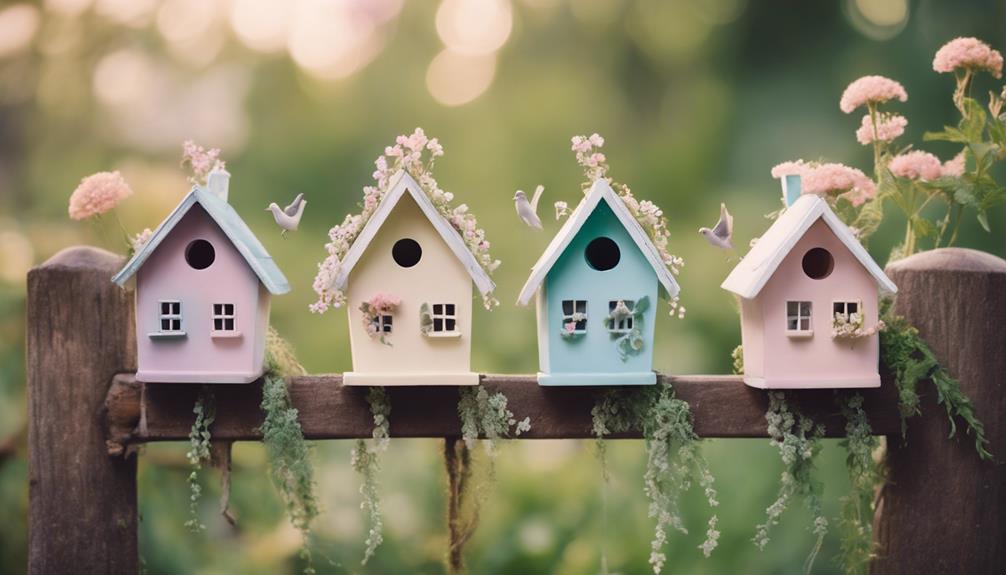
We can create charming spring cottage birdhouses with just a few simple crafting supplies from the dollar store. First, gather essential supplies like birdhouse kits, chalk paint, Mod Podge, and decorative paper. Then, paint the birdhouse base with Waverly chalk paint in agave, adding a vintage look with wax. Add decorative paper details using scrapbook paper and cardstock, and incorporate floral accents for a whimsical touch. Finally, assemble the cottage birdhouse by following the kit's instructions and adding personal touches. As we continue to craft, we'll explore more creative ways to customize our birdhouse and bring spring charm to our outdoor spaces.
Key Takeaways
• Use Dollar Tree birdhouse kits as a base for your spring cottage birdhouse project to save time and money.
• Apply Waverly chalk paint in vibrant colors to create a unique and charming look for your birdhouse.
• Add decorative paper details, such as scrapbook paper and cardstock, to give your birdhouse a touch of personality.
• Embellish your birdhouse with small floral accents, like colorful flowers and greenery, for a whimsical touch.
• Consider adding personal touches, like painting or decorating, to make your birdhouse truly one-of-a-kind.
Gathering Essential Crafting Supplies
As we start on this creative journey, we'll need to gather a few essential crafting supplies to transform our Dollar Store finds into charming spring cottage birdhouses. The first step is to collect the necessary materials, including birdhouse kits, which will serve as the base for our project.
Next, we'll need chalk paint in various colors to give our birdhouses a unique and personalized look. Additionally, we'll require Mod Podge, decorative cardstock, and scrapbook paper to add texture and visual interest to our creations. These supplies will allow us to apply multiple coats of paint, with drying time in between, to achieve a rich and vibrant color.
We'll also need white paint on hand for touch-ups and to create a cohesive look. By gathering these essential crafting supplies, we'll be well on our way to creating beautiful and unique spring cottage birdhouses that showcase our creativity and attention to detail.
Painting the Birdhouse Base
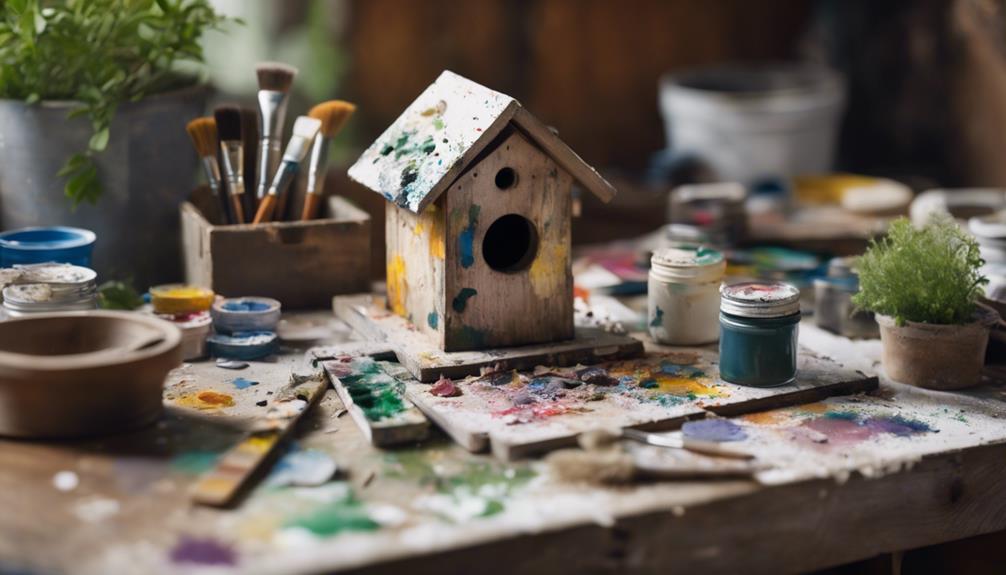
With our crafting supplies in hand, we're ready to bring our spring cottage birdhouses to life by painting the birdhouse base. This is where the magic happens, and our little birdhouses start to take shape.
To achieve a beautiful, solid base color, we'll apply two coats of Waverly chalk paint in agave, making sure that each coat dries completely before applying the next to prevent smudging or streaking.
Here are some essential tips to keep in mind:
- Use a small brush to touch up any areas that may have been missed or need extra coverage with white paint.
- Create a vintage look by applying wax over the dried paint, blending it in for a weathered effect.
- Maintain a smooth and even finish by taking your time and applying the paint and wax carefully to the birdhouse base.
Adding Decorative Paper Details
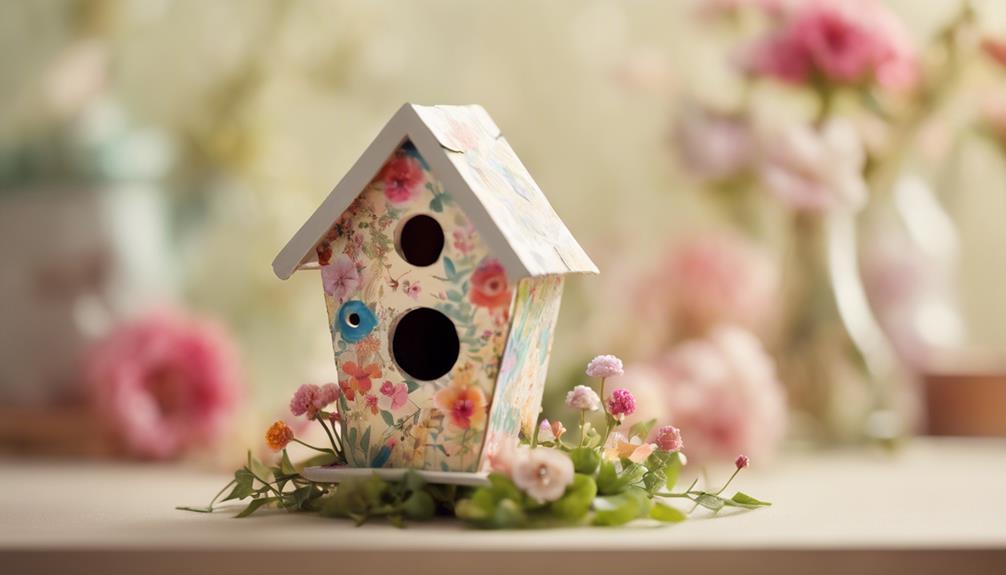
We're adding a personal touch to our spring cottage birdhouses by incorporating decorative paper details that infuse charm and character into these miniature homes. To guarantee this, we're using scrapbook paper and cardstock to create unique patterns and designs that reflect our personal style.
By mixing and matching different papers, we can create a cohesive and visually appealing final result. Next time, we might try adding rickrack trim or other embellishments to enhance the overall look of the birdhouse.
To make sure a secure hold, we'll attach the paper details using Mod Podge or glue. This technique is easy to master, and the results are well worth the effort.
With a little creativity, we can transform a plain birdhouse into a charming cottage that's full of personality. As we work on our birdhouses, we're reminded that it's the little details that make all the difference. By adding decorative paper details, we're creating a one-of-a-kind piece that's sure to delight.
Embellishing With Floral Accents
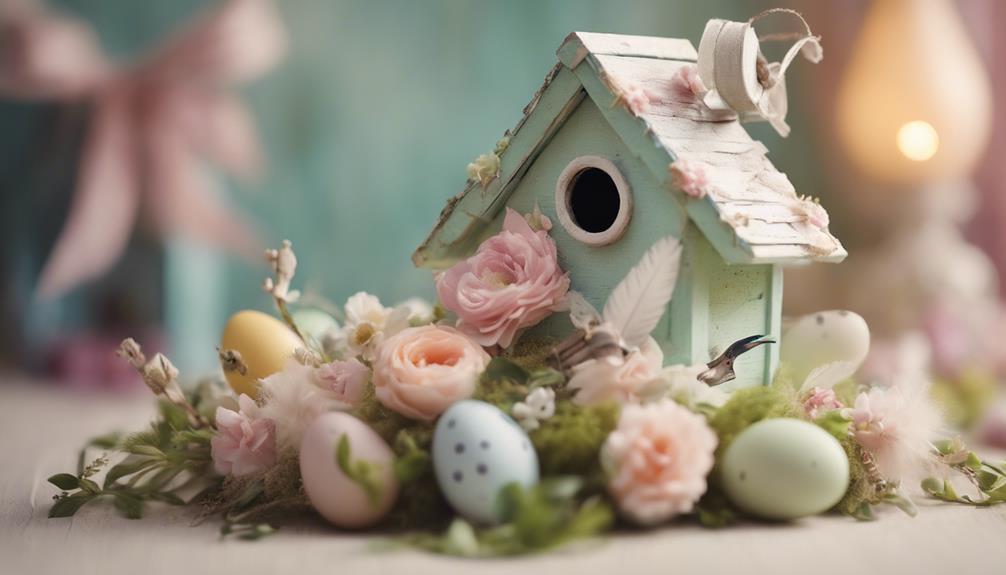
Now that we've added personality to our birdhouses with decorative paper details, let's take them to the next level by introducing a touch of whimsy with small floral accents.
We wanted to make our birdhouses stand out, and what better way to do that than with a splash of colorful flowers and greenery? To enhance our spring cottage birdhouses, we can use a variety of small flowers and foliage to create a natural and eye-catching look.
Here are some tips to keep in mind when embellishing with floral accents:
- Mix and match different flower shapes, sizes, and colors to create a visually appealing design.
- Consider using artificial flowers for a long-lasting and low-maintenance decorative option.
- Secure the floral accents with glue or adhesive to make certain they stay in place and withstand handling.
Assembling the Cottage Birdhouse
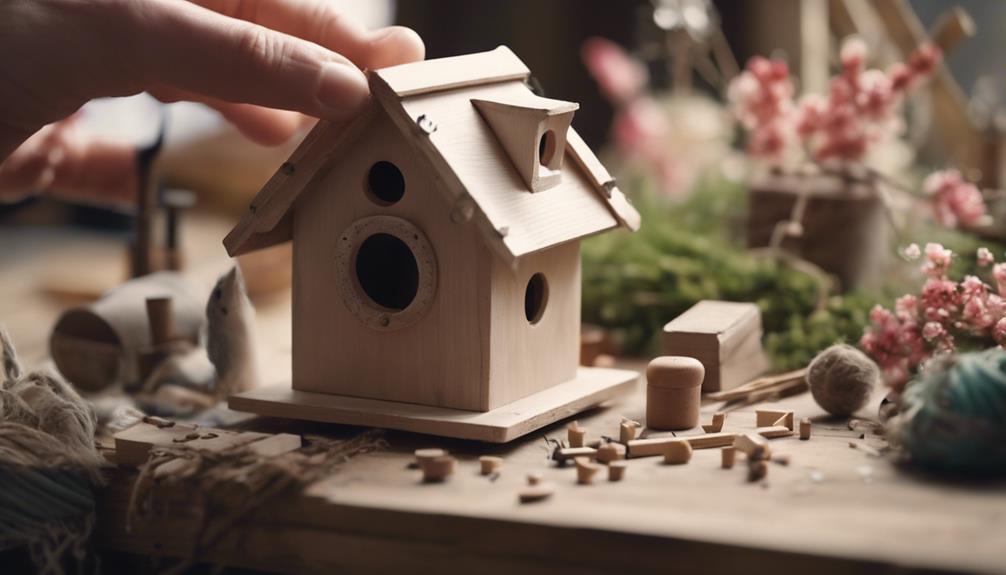
Let's get started on assembling our cottage birdhouse by following the instructions provided in the Dollar Tree birdhouse kit.
As we carefully read through the instructions, we'll make sure to pay attention to the finer details, such as aligning the roof and placing the windows correctly.
We'll use glue or nails to secure the pieces together, ensuring a sturdy construction that can withstand the elements.
As we assemble the birdhouse, we'll also think about adding our own personal touches, like painting or decorating, to make it truly unique.
If we're short on time, we can consider using a ready-made birdhouse from a craft store as an alternative.
Either way, we'll end up with a charming cottage birdhouse that's perfect for spring.
Frequently Asked Questions
Can I Use a Real Birdhouse Instead of a Wooden Birdhouse Shape?
We're wondering if we can ditch the wooden birdhouse shape and use a real birdhouse instead. Honestly, we think it's a great idea – it'll add a touch of authenticity to our DIY project!
Are There Any Alternatives to Decoupage Glue?
As we weave our creative tapestry, we ponder alternatives to decoupage glue, seeking a binding force that's strong yet gentle, like the threads of a spider's web. We find solace in mod podge, a trusty standby, or even white school glue, a humble hero.
How Do I Prevent the Paper Details From Peeling Off?
We prevent paper details from peeling off by applying a clear coat of varnish or Mod Podge after decoupage, ensuring a strong bond and protecting our artwork from wear and tear.
Can I Use Artificial Flowers Instead of Fresh Flowers?
We're wondering if artificial flowers are a viable substitute for fresh ones, and we think they're a great idea! They'll last longer and still add a pop of color, so go for it!
Is It Possible to Make This Project With Kids?
'As we dip our toes into the world of creativity, we ask: can little hands help craft this masterpiece? Absolutely! With patience and guidance, kids can contribute to this project, fostering a sense of pride and ownership.'
Conclusion
As we step back to admire our handiwork, our humble dollar store finds have been transformed into a charming spring cottage birdhouse, reminiscent of a 'hidden gem' tucked away in a lush garden.
The combination of soft hues and delicate details has yielded a whimsical retreat, beckoning birds to take up residence.
With a dash of creativity and some thriftiness, we've proven that beauty can indeed be found on a budget, as the saying goes, 'one person's trash is another person's treasure.'
Alfresco
Is an Alfresco a Verandah? Know the Difference!
Navigate the differences between an alfresco and a verandah to uncover which outdoor living space suits your needs best!
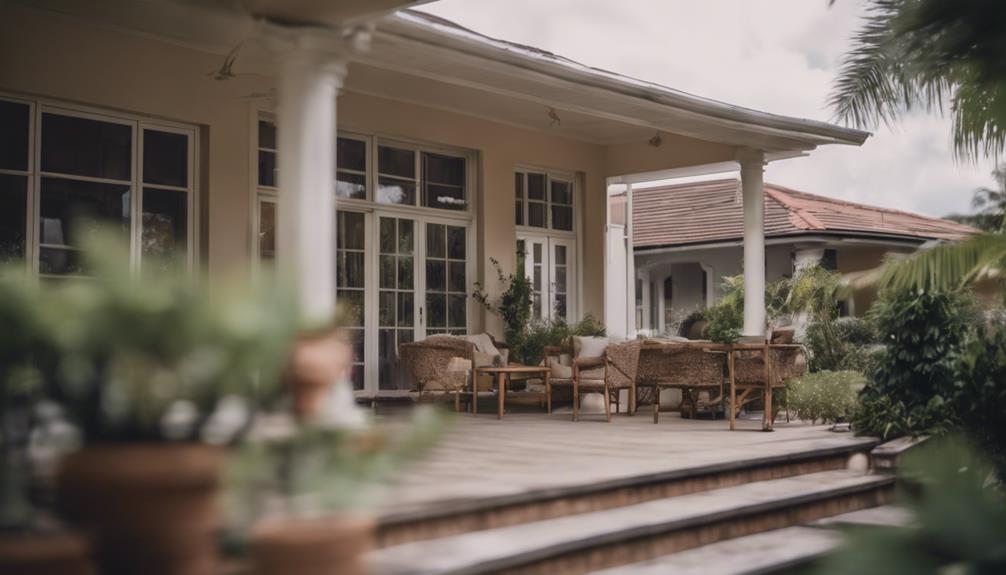
An alfresco and a verandah differ considerably in purpose and design. The alfresco serves as an outdoor dining extension under the main roof, while a verandah is ground-level, providing a covered area for relaxation. Alfrescos are oriented towards modern entertainment, include modern amenities, and attach to the main house's roof. Verandahs, on the other hand, are more traditional, overlooking the front of the house with a separate pitched roof. To explore further distinctions and choose wisely between an alfresco and a verandah, grasp their unique aspects and intended functionalities for your outdoor living needs.
Key Takeaways
- Alfresco serves as a modern outdoor dining and entertainment extension, while a verandah is a traditional covered space for relaxation.
- Alfrescos integrate with the main house roof and offer contemporary amenities, contrasting with verandahs' classic design elements.
- Alfrescos are ideal for outdoor dining year-round with modern finishes, while verandahs provide a sheltered area for socializing.
- Alfrescos use the main house roof for shade and are attached to the house, while verandahs have standalone covered roofs.
- Alfrescos prioritize modern materials like glass and steel for a sleek appearance, while verandahs typically use traditional materials like timber.
Alfresco Area Vs Verandah: Key Contrasts
When comparing an alfresco area to a verandah, the key contrasts lie in their design and intended use. An alfresco area serves as an outdoor extension for dining under the main roof, providing a space for casual meals and gatherings.
On the other hand, a verandah is a covered structure at ground level that connects front and back entrances, offering a place for relaxation and socializing in a traditional architectural style.
The alfresco area is specifically designed for outdoor dining and entertainment, often equipped with sliding doors for protection and to enhance the aesthetic value of a home. In contrast, verandahs are used for small parties and overlook the front of the house, providing a covered area to enjoy the outdoors while being protected from the elements.
While alfrescos seamlessly extend the home's living space, verandahs act as a connection space between indoor and outdoor areas. The alfresco area is commonly associated with modern outdoor living, while verandahs offer a more traditional touch to the architectural design of a house.
Design Variances Between Alfresco and Verandah
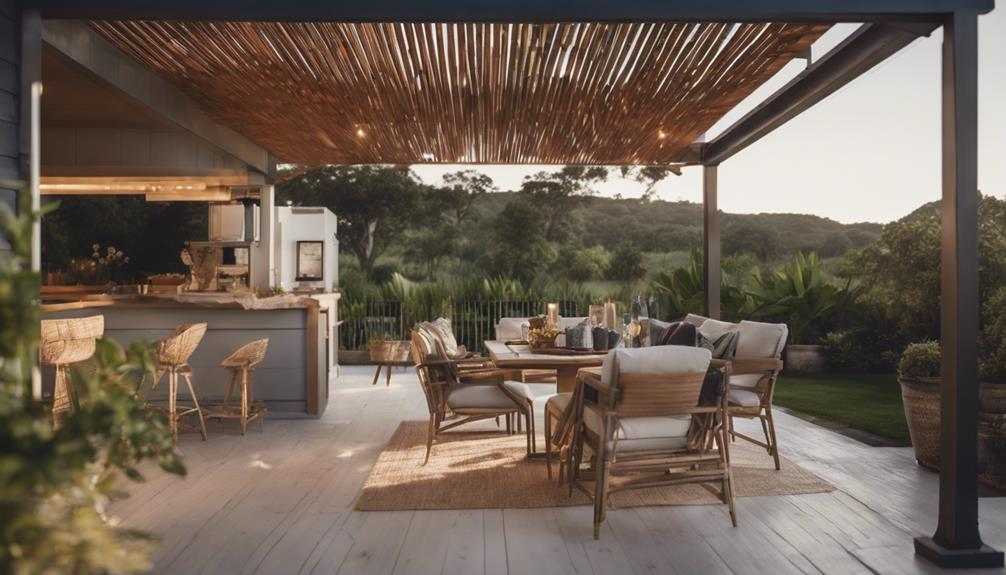
When comparing the design variances between an alfresco and a verandah, it's important to analyze the roof structures, functional spaces, and material selections. The roof structure of an alfresco tends to be integrated into the main house roof, creating a seamless indoor-outdoor flow, while verandahs often feature a separate pitched roof design.
Functional space variations highlight how alfrescos are tailored for dining and entertaining, whereas verandahs serve as sheltered passageways around the house, emphasizing a historical architectural connection.
Material selection variances further distinguish these outdoor spaces, with alfrescos featuring modern amenities and finishes, contrasting with the classic design elements of verandahs.
Roof Structure Differences
In distinguishing between alfrescos and verandahs, one key aspect that sets them apart is their roof structures. Alfrescos typically utilize the main roof of the house for shade, blending seamlessly with the existing architecture. On the other hand, verandahs are standalone covered structures at ground level, having their own distinct roof separate from the main house. To help visualize the differences, refer to the table below:
| Aspect | Alfresco | Verandah |
|---|---|---|
| Location | Attached to the main house | Standalone structure at ground level |
| Roof Structure | Uses the main roof for shade | Has its own covered roof |
| Purpose | Outdoor dining under existing roof | Connects front and back entrances of a home |
| Design | Integrates with house design | Traditional connecting space |
| Size | Often smaller, part of the main structure | Longer and narrower for small gatherings |
Understanding these distinctions can assist in making informed decisions when considering the addition of either an alfresco or a verandah to your property.
Functional Space Variations
For understanding the design variances between an alfresco and a verandah, consider their functional space variations. An alfresco is an outdoor extension of the main living area, designed for modern features like outdoor kitchens and dining areas. It serves as a covered structure, offering protection from the elements year-round and can be partially enclosed for added comfort.
In contrast, a verandah is a more traditional covered structure attached along the front, back, or side of a house, serving as a space between indoors and outdoors. Verandahs are open structures that provide shade and a relaxing outdoor space. Alfrescos are commonly used for outdoor dining and entertaining purposes, while verandahs are ideal for relaxing, reading, or enjoying the surrounding landscape views.
While alfrescos are typically built as extensions of the home under the main roof, verandahs can be freestanding or attached structures with various roof options like flat, skillion, or gable roofs.
Material Selection Variances
If you're considering the design variances between an alfresco and a verandah, the material selection plays an essential role in distinguishing these outdoor living spaces. Alfrescos often incorporate modern materials like glass and steel, giving them a contemporary feel, while verandahs typically utilize traditional materials such as timber for a more classic appearance.
When it comes to design elements, verandahs may include decorative features like fretwork or balustrades for elegance, whereas alfrescos focus on sleek, functional designs. Prioritizing weather resistance and durability, alfrescos commonly use materials like aluminum and composite decking, contrasting with verandahs that may opt for hardwoods like cedar or merbau to achieve a natural aesthetic.
Additionally, alfrescos may integrate high-tech materials like UV-resistant polycarbonate roofing and composite cladding for low maintenance, setting them apart from the more rustic feel of verandahs. The choice of materials significantly impacts the overall style, maintenance needs, and longevity of these outdoor spaces.
Functional Disparities of Alfresco and Verandah
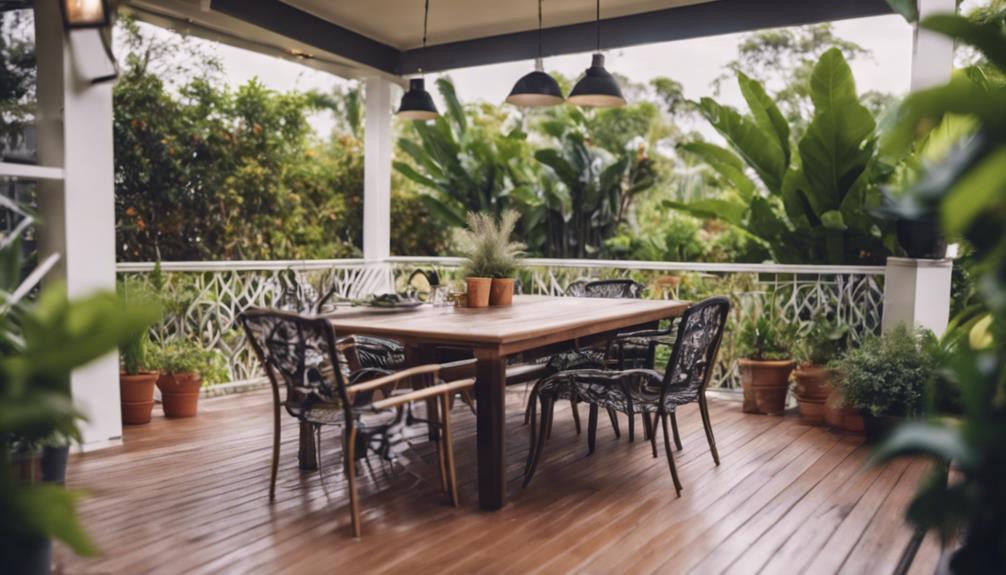
An alfresco and a verandah serve distinct functions within a home, showcasing usage variations and design elements that differentiate the two structures.
Alfrescos are designed to create an integrated outdoor living space under the main roof, often equipped with amenities like outdoor kitchens, ideal for dining and entertainment.
In contrast, verandahs act as covered passageways or social spaces, offering a connecting area between the indoors and outdoors, commonly used for relaxation or to enjoy the front view of the house.
Usage Variations
The functional disparities between alfrescos and verandahs are evident in their distinct usage variations. Alfrescos are primarily designed for outdoor dining and entertaining, creating a space for leisure activities and social gatherings. They offer a seamless extension of the indoor living space, blurring the lines between indoor and outdoor areas. Alfrescos often come equipped with amenities like outdoor kitchens and dining areas to enhance the overall experience.
On the other hand, verandahs serve a simpler purpose, acting as covered pathways or connecting areas within a home. They're typically used for small gatherings or as a relaxation spot, providing shelter and linking different parts of the house. Verandahs prioritize functionality over elaborate design features, focusing on their role as a covered structure rather than a dedicated entertainment space.
Essentially, while alfrescos cater to outdoor living and dining experiences, verandahs serve as practical connectors within a property.
Design Elements
When comparing the design elements of alfrescos and verandahs, it becomes evident that they serve distinct functional purposes in enhancing outdoor living spaces. Alfrescos are designed as outdoor extensions for dining under the main roof, providing a smooth shift between indoor and outdoor areas. They focus on creating a smooth flow, using the main roof for shade and offering protection from the elements year-round. These covered structures not only enhance the aesthetic value of a home but also cater to outdoor dining and entertainment needs.
On the other hand, verandahs are typically at ground level, overlooking the front or back of a house, and are more commonly used for relaxing or enjoying the outdoor view. Their design elements revolve around providing a covered pathway or sitting area. While alfrescos emphasize smooth shifts and outdoor extensions, verandahs prioritize offering a covered space for various activities, albeit with a different aesthetic appeal.
Comparing Alfresco and Verandah Aesthetics
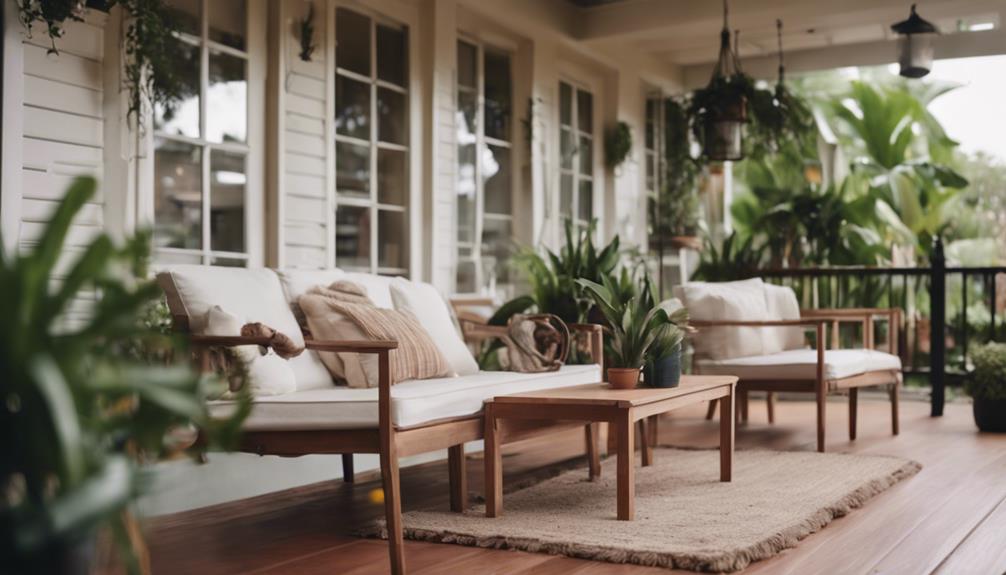
Alfrescos and verandahs present distinct aesthetics that showcase their unique design features and styles. While alfrescos lean towards a modern and sleek appearance, verandahs exude a more traditional and classic charm. The table below highlights some key differences in the aesthetics of alfrescos and verandahs:
| Aspect | Alfresco | Verandah |
|---|---|---|
| Roof Design | Often a part of the main roof structure | Separate roof covering the structure |
| Supporting Columns | Minimal or absent | Typically adorned with columns or posts |
| Architectural Style | Contemporary | Traditional |
Alfrescos tend to prioritize a seamless integration of indoor and outdoor spaces, often featuring sliding doors and a modern appeal. In contrast, verandahs boast a more timeless look with prominent columns and a roof that extends from the main structure. These differences in design elements contribute to the overall aesthetic and feel of each outdoor living space.
Alfresco Vs Verandah: Usage Distinctions
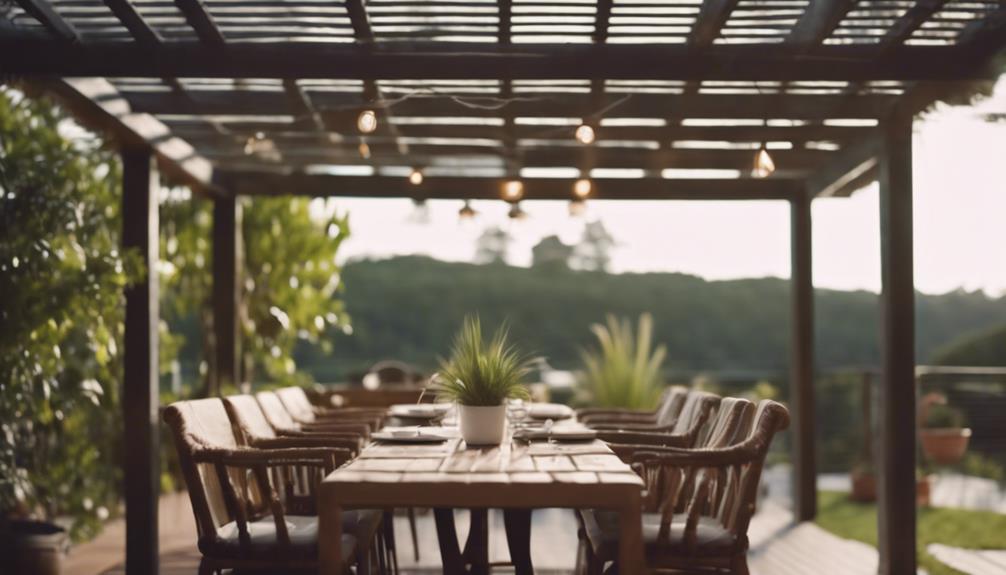
Highlighting the versatile functionality of outdoor living spaces, alfrescos and verandahs offer distinct usage distinctions that cater to different preferences and needs.
Here are some key differences to help you understand how alfrescos and verandahs are used:
- Alfresco:
- An alfresco is an outdoor extension primarily designed for dining under the main roof.
- It enhances the aesthetic appeal of a home and often includes sliding doors for protection during various weather conditions.
- Alfrescos are typically associated with outdoor dining and entertaining spaces, providing a cozy and inviting atmosphere for gatherings.
- Verandah:
- In contrast, a verandah is a covered ground-level structure that connects the front and back entrances of a house.
- Verandahs can be utilized for small gatherings or as relaxing spots overlooking the front of the house.
- They serve as covered pathways or sitting areas along the perimeter of a property, facilitating easy shifts between indoor and outdoor spaces.
Structural Differences: Alfresco Vs Verandah
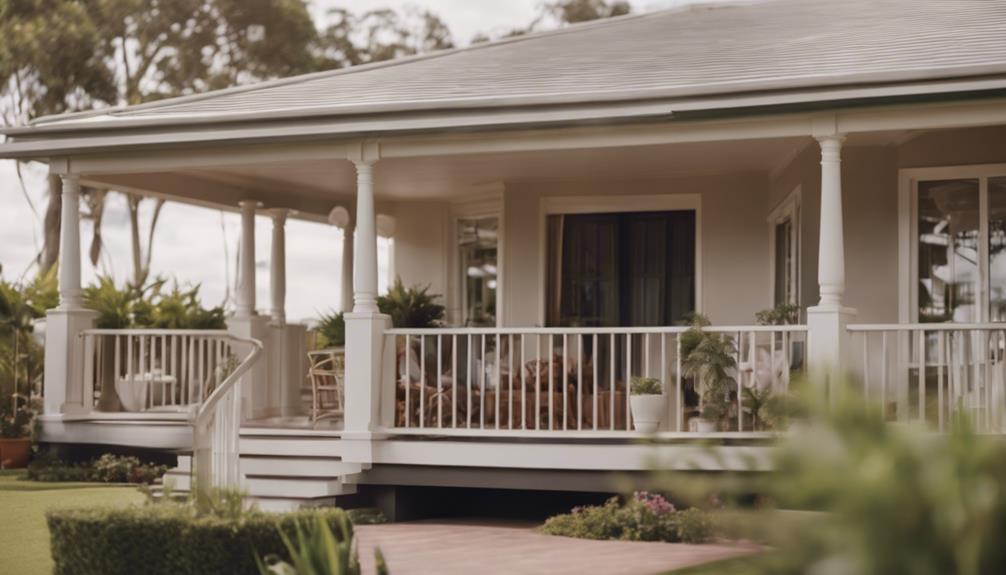
When comparing an alfresco to a verandah, structural differences are evident in the roofing materials used and the level of enclosure. Alfrescos typically feature roofs that are extensions of the main house structure, providing a high level of enclosure with sliding doors for protection.
Verandahs, on the other hand, may have different roofing materials and offer a more open design, often acting as covered walkways or sitting areas.
Roofing Materials Used
Utilizing the main roof of the house for support, alfrescos commonly employ roofing materials such as Colorbond steel or insulated panels. Verandahs, on the other hand, often feature independent roofing materials like corrugated iron or timber shingles.
When considering the roofing materials used in alfrescos and verandahs, several key differences emerge:
- Integration with the Main House: Alfrescos tend to integrate more seamlessly with the main house due to their shared roofing materials, creating a cohesive look. In contrast, verandahs offer a distinct aesthetic appeal by utilizing independent roofing materials.
- Aesthetic Variation: The choice of roofing material for alfrescos or verandahs can have a notable impact on the overall aesthetic of the outdoor structure. Colorbond steel exudes a modern and sleek appearance, while timber shingles provide a more traditional and rustic look.
- Durability and Maintenance: The selection of roofing materials also influences the durability and maintenance requirements of alfrescos and verandahs. Insulated panels offer enhanced insulation and energy efficiency for alfrescos, whereas corrugated iron may require more frequent maintenance for verandahs.
Level of Enclosure
For a clear distinction between an alfresco and a verandah regarding structural differences, consider the level of enclosure each outdoor space provides. An alfresco is typically more enclosed than a verandah, offering walls or privacy screens that provide a sense of coziness and protection. This enclosed structure allows for year-round use, shielding you from the elements while enjoying outdoor dining or entertainment. On the other hand, a verandah is more open, serving as a covered passage from indoors to outdoors. Verandahs are commonly used for relaxation and admiring the surroundings, creating a welcoming entry to your home. To better understand the differences, let's take a look at the comparison table below:
| Aspect | Alfresco | Verandah |
|---|---|---|
| Level of Enclosure | Enclosed with walls or screens | More open with less enclosure |
| Year-round Use | Suitable for all seasons | May be less comfortable in extreme weather |
| Protection | Offers protection from elements | Provides minimal shelter from weather |
| Outdoor Dining | Ideal for outdoor dining experiences | Can be used for light meals or relaxation |
| Entertainment | Great for hosting gatherings and events | Suitable for relaxing and enjoying views |
Alfresco or Verandah: Which to Choose?
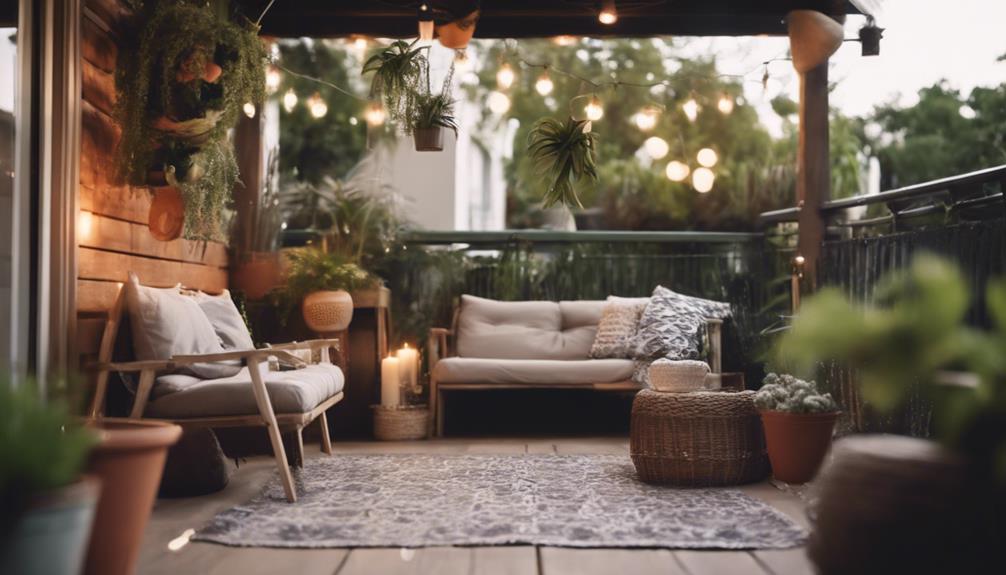
Considering whether to opt for an alfresco or a verandah for your outdoor space can depend on your lifestyle preferences and desired functionality. Both options have their unique characteristics that cater to different needs. Here are some key points to help you make an informed decision:
- Functionality:
- Alfrescos are ideal for adding an outdoor living space that seamlessly connects to your home, perfect for dining and entertaining.
- Verandahs provide a covered area that serves as a connecting space between the indoors and outdoors.
- Design:
- Alfrescos often feature outdoor kitchens, dining areas, and furniture, enhancing the outdoor living experience.
- In contrast, verandahs offer a covered space for relaxation or small gatherings.
- Purpose:
- While alfrescos focus on expanding your living area outdoors, verandahs primarily function as covered walkways or sitting areas.
Consider your lifestyle needs and desired functionality to determine which option best suits your home.
Outdoor Living: Alfresco Vs Verandah
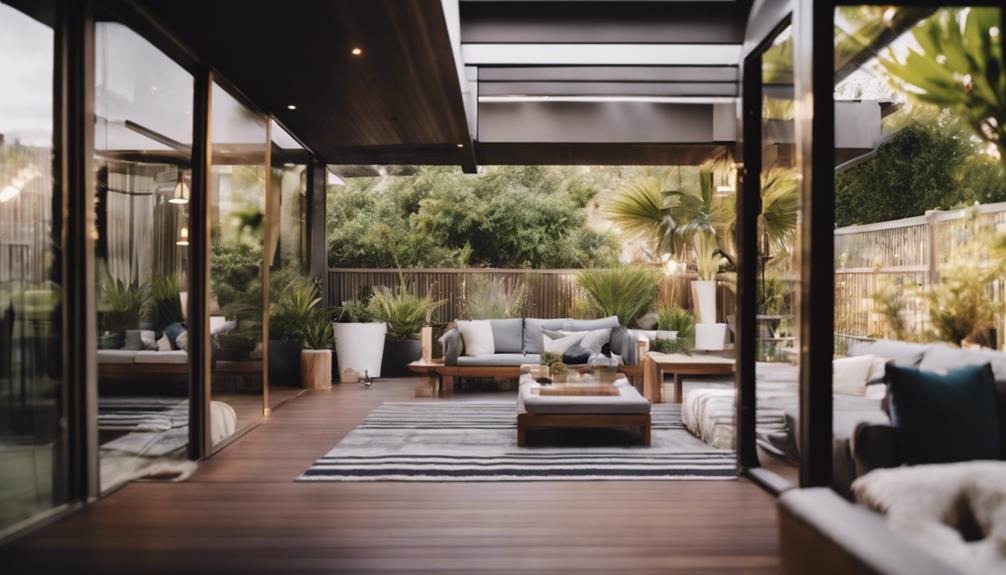
When considering your outdoor living space, it's crucial to understand the specific characteristics of each option. Below is a comparison table highlighting key differences between an alfresco and a verandah:
| Aspect | Alfresco | Verandah |
|---|---|---|
| Location | Connected to the main house | Along the front, back, or side of the house |
| Purpose | Designed for dining and entertaining | Serves as a connecting space between indoors and outdoors |
| Integration | Offers a seamless look with the main house | Can vary in size and shape |
| Features | Often includes sliding doors for protection | Typically has open sides for ventilation |
| Function | Enhances the aesthetic value of the home | Provides a covered area for relaxation and social gatherings |
Understanding these distinctions can help you make an informed decision when planning your outdoor living space.
Alfresco Vs Verandah: Home Value Impact
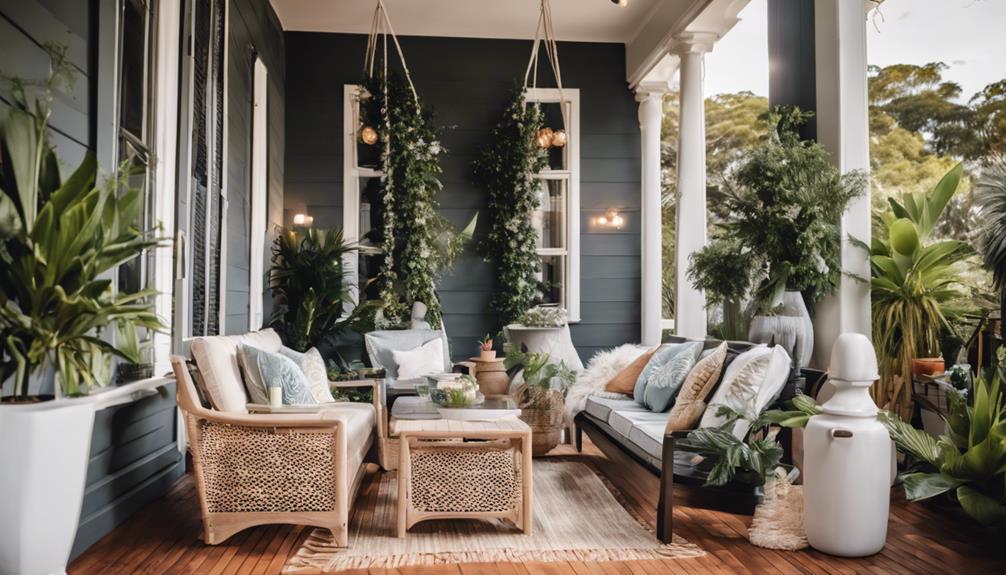
Understanding the impact on home value between an alfresco and a verandah is key when planning your outdoor living space. When considering whether to add an alfresco or a verandah to your home, here are some key points to keep in mind:
- Home Value Increase: Adding an alfresco can potentially raise your home's value by up to 20%, making it a lucrative investment for homeowners looking to increase their property's worth.
- Traditional Charm vs. Modern Appeal: While a verandah typically adds 12-15% to the value of a home, alfrescos are perceived as more modern and luxurious. The choice between the two can depend on whether you prefer traditional charm or modern appeal.
- Buyer Attraction: Both alfrescos and verandahs can enhance curb appeal and attract potential buyers. However, alfrescos, being more contemporary, might have a broader appeal to a modern buyer demographic.
Making the Choice: Alfresco or Verandah
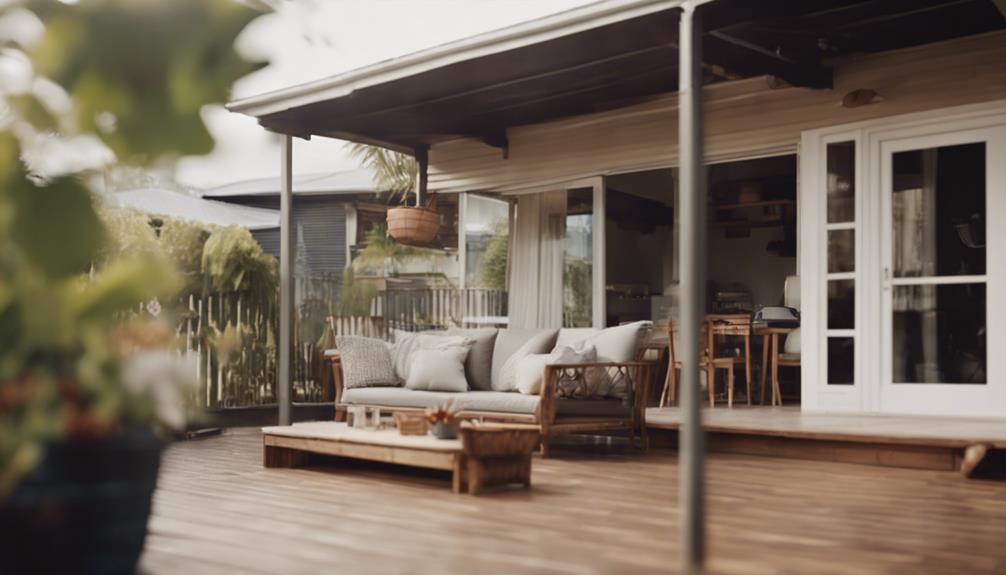
When deciding between an alfresco and a verandah for your outdoor space, consider the primary function and desired aesthetic appeal of each option.
An alfresco is an outdoor living space connected to the main house, offering protection from the elements and customizable features like outdoor kitchens for dining and entertaining.
On the other hand, a verandah is a covered structure typically attached to the front, back, or side of a house, serving as a connecting space between indoors and outdoors, ideal for relaxation and enjoying the view.
The choice between an alfresco and a verandah depends on the function you envision for your outdoor living space. If you prioritize seamless integration with your main house and desire a space for hosting gatherings and meals, an alfresco might be the ideal option.
Conversely, if you seek a covered area for unwinding and appreciating the surroundings, a verandah could better suit your needs. Evaluate your preferences, location, and design goals to make an informed decision that complements your outdoor lifestyle.
Frequently Asked Questions
What Is Considered a Verandah?
When considering what is considered a verandah, think of a covered structure attached to a house, offering a sheltered outdoor space. It serves as an extension of the main roof, providing a cozy connection to the outdoors.
What Is the Difference Between a Veranda and a Verandah?
When distinguishing between a veranda and a verandah, note that they both provide covered outdoor spaces attached to a house. The key difference lies in spelling variations, with "veranda" being more common internationally and "verandah" in Australia.
What Is an Alfresco on a House?
An alfresco on a house is an outdoor living area designed for dining and entertaining. It seamlessly connects indoor and outdoor spaces under the main roof. Alfrescos provide protection from the elements and a cozy ambiance.
Is a Pergola and Verandah the Same Thing?
A pergola and a verandah are not the same thing. A verandah is attached to the main house with a covered roof, while a pergola stands freely with an open slatted roof for climbing plants.
Conclusion
In the end, choosing between an alfresco area and a verandah comes down to personal preference and lifestyle needs. Each option offers distinct design, functionality, and aesthetic features that cater to different outdoor living experiences.
Whether you opt for the open-air appeal of an alfresco or the traditional charm of a verandah, both can enhance your home's value and provide a delightful space for relaxation and entertainment. Make your choice wisely to create the perfect outdoor oasis for your home.
-

 Craft and Textiles2 months ago
Craft and Textiles2 months ago15 Best Places to Buy Appliances for Your Home – Top Retailers Reviewed
-

 Decorative Throws2 months ago
Decorative Throws2 months agoIs It Better to Dry Clean Blankets?
-

 Vetted3 weeks ago
Vetted3 weeks ago14 Best Personalized Father's Day Gifts for Your Husband – Show Him You Care
-

 Yarn2 months ago
Yarn2 months agoIs Yarn Natural or Manmade? Unravel the Truth
-

 Tableware and Dining Accessories2 months ago
Tableware and Dining Accessories2 months agoWhat Is the Meaning of the Word Tableware
-

 Tableware and Dining Accessories2 months ago
Tableware and Dining Accessories2 months agoWhat Is the Hindi Meaning of Tableware
-

 Craft and Textiles2 months ago
Craft and Textiles2 months ago15 Best Cordless Mowers for Effortless Lawn Care – Top Picks of 2024
-

 Craft and Textiles2 months ago
Craft and Textiles2 months ago15 Best Battery-Powered Leaf Blowers for Effortless Yard Work



















